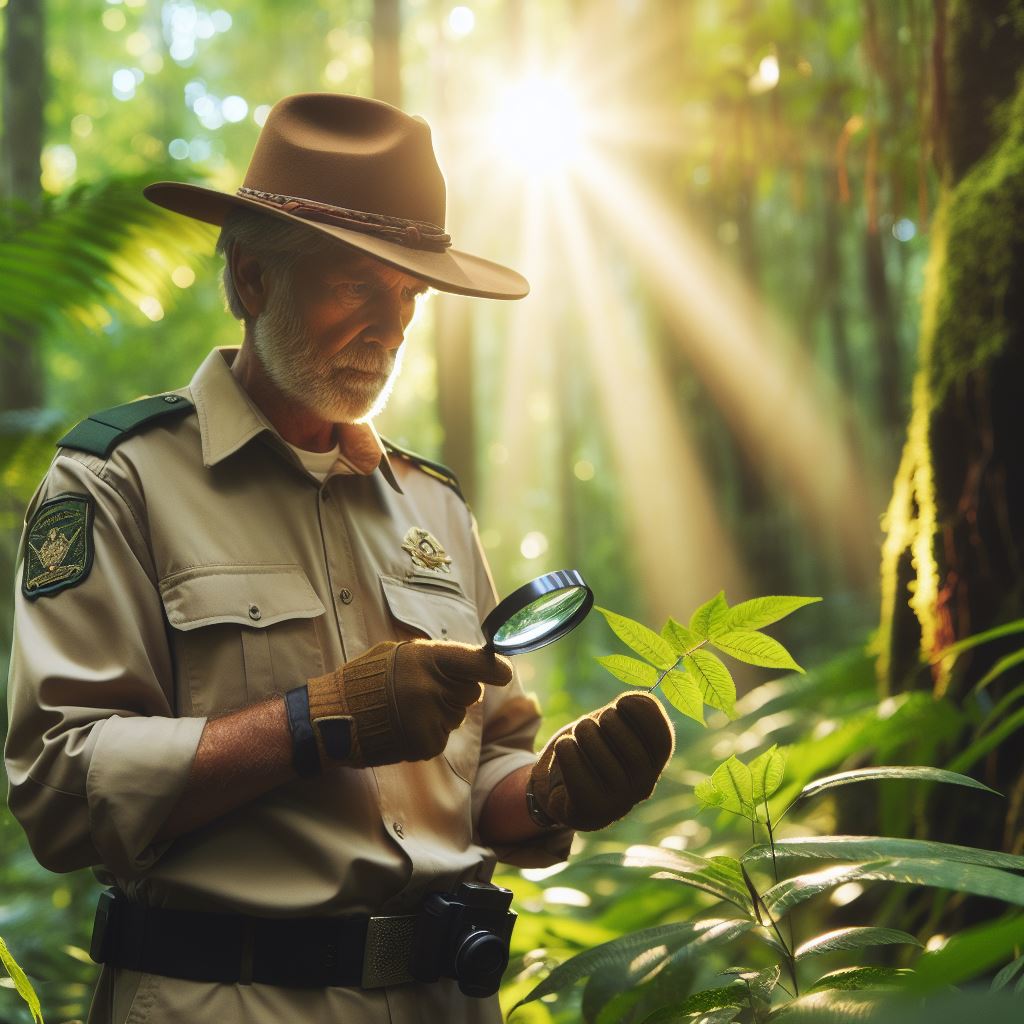Introduction
Wildlife protection aims to safeguard the survival and well-being of various species. The forester’s role in wildlife protection is vital in ensuring sustainable ecosystems. In this article we will look at Forester Wildlife Protection.
This blog post provides an overview of wildlife protection and emphasizes the forester’s crucial role.
Wildlife protection is essential for preserving biodiversity and maintaining ecological balance.
It involves the conservation and management of different species, their habitats, and natural resources.
The forester’s role in this endeavor is highly significant.
Foresters are professionals who play a crucial role in managing forests, including protecting and conserving wildlife.
Foresters are responsible for maintaining the appropriate habitat conditions that support diverse wildlife populations.
They assess ecosystems, monitor wildlife populations, and implement measures to mitigate human activities’ negative impacts.
By collaborating with conservation organizations and local communities, foresters establish strategies to protect endangered species and restore habitats.
This blog post will focus on highlighting the forester’s role in wildlife protection.
It will explore their responsibilities, skills, and knowledge required to effectively manage and conserve wildlife.
Additionally, it will discuss the challenges faced by foresters in ensuring the long-term survival of species and maintaining healthy ecosystems.
By understanding the forester’s role, readers will gain insight into the importance of their contributions to wildlife protection.
They will also develop an appreciation for the complexities involved in preserving biodiversity and the need for collaboration among various stakeholders.
In the next sections, we will delve deeper into the specific tasks of foresters, their impact on wildlife conservation, and successful wildlife protection initiatives undertaken by foresters worldwide.
Stay tuned to discover the critical role foresters play in safeguarding our precious wildlife and natural resources.
What is a forester?
Definition and qualifications of a forester
- A forester is a professional who specializes in the management and conservation of forests.
- To become a forester, one usually needs a bachelor’s degree in forestry or a related field.
- Other qualifications may include knowledge in biology, ecology, and natural resource management.
- Foresters should also have strong analytical, problem-solving, and communication skills.
- They must be physically fit and comfortable working in outdoor environments.
Key responsibilities and skills of a forester
Forest management and planning
- Foresters develop and implement strategies for the sustainable management and use of forest resources.
- They assess and monitor the health of forests, identifying potential risks and implementing measures to mitigate them.
Conservation and restoration
- Foresters play a vital role in conserving and restoring ecosystems by addressing issues such as deforestation and habitat loss.
- They develop plans for reforestation, afforestation, and habitat restoration to enhance biodiversity and preserve wildlife.
Wildlife management
- Foresters work closely with wildlife biologists to manage wildlife populations and their habitats.
- They conduct surveys and assessments to determine the health and abundance of different species.
- Foresters also implement measures to protect sensitive habitats and promote the coexistence of wildlife and human activities.
Forest policy and regulation
- Foresters have expertise in forest policy and regulation, providing guidance to governments and organizations.
- They ensure compliance with environmental laws and regulations, facilitating sustainable forest practices.
Community engagement and education
- Foresters collaborate with local communities, educating them about the importance of forests and wildlife conservation.
- They promote awareness and participation in sustainable forest management practices.
Research and innovation
- Foresters conduct research to improve forest management techniques and develop innovative solutions.
- They stay updated on the latest advancements in forestry and contribute to scientific knowledge and practices.
In fact, a forester is a highly skilled professional responsible for the management, conservation, and protection of forests and wildlife.
They possess a strong background in forestry and related fields, along with essential qualifications and skills.
Through their work, foresters ensure the sustainable use of forest resources, conserve biodiversity, and promote the coexistence of wildlife and human activities.
Their expertise is essential in addressing environmental challenges and shaping forest policies for a more sustainable future.
Read: Soil Health and Its Importance in Aussie Farms
The role of foresters in wildlife protection
Conservation of habitats and ecosystems
- Foresters identify and assess suitable habitats for wildlife.
- They design and implement habitat restoration programs.
- Foresters also monitor and evaluate habitat conditions to ensure their effectiveness.
Foresters play a vital role in wildlife protection, particularly in the conservation of habitats and ecosystems.
By identifying and assessing suitable habitats for wildlife, foresters ensure that these areas can support diverse species and provide essential resources.
Through their expertise, they design and implement habitat restoration programs, aiming to restore natural ecosystems and enhance biodiversity.
Additionally, foresters are responsible for monitoring and evaluating habitat conditions regularly.
By doing so, they can determine the effectiveness of conservation efforts and make necessary adjustments to ensure the long-term sustainability of these habitats.
This involves assessing factors like vegetation cover, water availability, and overall habitat quality.
Wildlife population management
- Foresters conduct surveys and assessments of wildlife populations.
- They implement measures to protect endangered species.
- Foresters manage hunting and fishing activities to ensure sustainable practices.
Wildlife population management is another crucial aspect of a forester’s role. They conduct surveys and assessments of wildlife populations, gaining insights into species abundance, distribution, and health.
With this information, foresters implement measures to protect endangered species, such as habitat preservation, reducing human disturbance, and enforcing legal regulations.
Furthermore, foresters are actively involved in managing hunting and fishing activities to maintain sustainable practices. They ensure that these activities are carried out responsibly and in accordance with conservation objectives.
By setting appropriate hunting seasons, bag limits, and enforcing regulations, foresters strive to balance the needs of wildlife conservation and the interests of recreational activities.
Prevention and mitigation of wildlife conflicts
- Foresters identify potential human-wildlife conflict areas.
- They develop strategies to minimize conflicts and potential harm.
- Foresters play a crucial role in educating the public on coexisting with wildlife.
Prevention and mitigation of wildlife conflicts also fall under the forester’s purview.
They identify potential areas where human-wildlife conflicts may arise, such as regions with overlapping territories.
With this knowledge, foresters develop strategies to minimize conflicts and potential harm to both humans and wildlife.
This may involve implementing deterrent measures, like wildlife-friendly fences or the strategic placement of deterrent devices to prevent wildlife encroachment in human settlements.
Education plays a critical role in fostering coexistence between humans and wildlife.
Foresters play a crucial role in educating the public about the importance of wildlife conservation, providing information on how to minimize conflicts, and promoting responsible behavior around wildlife.
Through awareness campaigns, workshops, and community engagement, foresters raise public awareness, thereby ensuring a more harmonious relationship between humans and wildlife.
In a nutshell, foresters have a multifaceted role in wildlife protection.
Their involvement in habitat conservation, wildlife population management, and conflict prevention is essential for maintaining the delicate balance between human activities and the preservation of our natural ecosystems.
Through their proactive efforts and expertise, foresters contribute significantly to the overall well-being of wildlife and their habitats.
Read: Australian Cattle Farming: Methods and Myths
Collaboration with other stakeholders
Collaboration is key when it comes to wildlife protection, and foresters play a vital role in working with various stakeholders to ensure the preservation of our precious wildlife.
In this section, we will explore the different ways in which foresters collaborate with other stakeholders, including government agencies and local communities.
Working with government agencies
Foresters work closely with wildlife authorities and conservation departments to coordinate efforts in protecting wildlife. This collaboration allows for a more efficient and effective approach to wildlife conservation.
By partnering with these agencies, foresters can leverage their expertise and resources to address various wildlife-related challenges.
One important aspect of collaboration with government agencies is the coordination of efforts.
Foresters work hand in hand with wildlife authorities and conservation departments to ensure that their actions are aligned with the overall objectives of wildlife protection.
This coordination helps in avoiding duplication of efforts and ensures the optimal utilization of resources.
Additionally, foresters also provide their expertise and guidance on wildlife protection policies to the government agencies.
Their knowledge and experience in managing and conserving wildlife habitats are valuable in shaping policies that are effective and sustainable.
By actively participating in the development and implementation of wildlife protection policies, foresters contribute to creating a favorable environment for wildlife.
Partnership with local communities
Foresters recognize the significance of involving local communities in wildlife protection efforts.
Collaborating with communities not only raises awareness about the importance of preserving wildlife but also creates a sense of ownership and responsibility among the locals.
Engaging with locals is crucial in raising awareness about wildlife protection. Foresters organize educational campaigns and awareness programs to inform the community about the value of wildlife and the threats they face.
By spreading knowledge, foresters inspire individuals to become active participants in safeguarding wildlife.
Your Personalized Career Strategy
Unlock your potential with tailored career consulting. Get clear, actionable steps designed for your success. Start now!
Get StartedMoreover, foresters involve local communities in conservation initiatives and citizen science projects. This partnership allows for a more comprehensive approach to wildlife protection.
Local communities have valuable knowledge about the area, including behavioral patterns of wildlife and historical data. By involving communities in conservation initiatives, foresters can gather crucial information and insights that aid in wildlife management.
Conservation initiatives can take various forms, such as habitat restoration, wildlife monitoring, and capacity building programs.
By actively engaging with locals and involving them in such initiatives, foresters ensure that the efforts are sustainable and have a positive impact on the local community as well.
In review, collaboration with other stakeholders is vital for effective wildlife protection, and foresters play a significant role in this process.
Working with government agencies allows foresters to coordinate efforts and provide expertise in shaping wildlife protection policies. Partnering with local communities raises awareness and encourages active participation in conservation initiatives.
By collaborating with different stakeholders, foresters create a strong network that enhances the overall success of wildlife protection efforts.
Explore Further: Fishing Seasons: Best Times in Australia
Discover More: Roles of Enviro Managers in Aussie Agriculture
Uncover the Details: Crop Diversity: Agri Science’s Role
Challenges faced by foresters in wildlife protection:
Limited resources and budget constraints
Foresters face challenges due to a lack of adequate resources and budget constraints.
The limited funding hinders their ability to effectively protect wildlife and their habitats.
With insufficient funds, foresters struggle to implement and maintain necessary conservation efforts.
This can lead to a decline in wildlife populations and the degradation of their ecosystems.
Without adequate resources, foresters find it difficult to monitor and manage wildlife populations effectively.
They also face challenges in conducting research and implementing innovative conservation strategies.
The lack of funds and resources often forces foresters to prioritize certain areas or species over others.
Consequently, some wildlife may receive less attention and protection, further endangering their existence.
Budget constraints can also impact the training and capacity building of foresters to cope with emerging issues.
Despite these challenges, foresters strive to find alternative funding sources and optimize resource allocation.
By collaborating with other stakeholders and seeking external support, they aim to overcome financial limitations.
In the face of limited resources, foresters must prioritize wildlife conservation initiatives to achieve the best possible outcomes.
Balancing competing interests and priorities
Foresters often face the challenge of balancing competing interests and priorities in wildlife protection.
Wildlife habitats often overlap with areas used for agriculture, infrastructure development, or human settlements.
Foresters must strike a balance between conserving wildlife and meeting the needs of other sectors.
This requires careful planning and effective communication with different stakeholders.
The conflicts arising from competing interests can sometimes hinder the implementation of wildlife protection measures.
Foresters need to find common ground and negotiate with various stakeholders to ensure sustainable solutions.
They must consider the socio-economic needs of local communities while safeguarding wildlife habitats.
Balancing competing interests also involves addressing conflicting objectives among different conservation organizations.
Coordination and collaboration become crucial to finding solutions that promote both human and wildlife welfare.
Foresters may need to be mediators, facilitating dialogue and reaching consensus among diverse stakeholders.
By promoting the value of wildlife and its ecosystem services, foresters can foster understanding and support.
They also play a vital role in advocating for policies that prioritize wildlife protection in decision-making processes.
Addressing the effects of climate change on wildlife habitats
Foresters face the challenge of mitigating and adapting to the effects of climate change on wildlife habitats.
Rising temperatures, changing precipitation patterns, and extreme weather events pose significant threats.
Climate change alters habitat suitability and disrupts ecological processes on which wildlife depend.
Foresters must develop strategies to manage protected areas and habitats in the face of these changes.
They need to identify climate-resilient species and promote their conservation within their ecosystems.
Foresters play a critical role in monitoring and assessing the impacts of climate change on wildlife.
They need to incorporate climate change considerations into their management plans and conservation policies.
Adapting to climate change requires foresters to collaborate with scientists, policymakers, and local communities.
Implementing sustainable land-use practices and promoting habitat connectivity are crucial for wildlife survival.
Foresters need to prioritize the conservation of carbon-rich ecosystems to mitigate climate change impacts.
By integrating climate change considerations into their work, foresters contribute to long-term wildlife protection.
In essence, foresters face multiple challenges in wildlife protection.
Limited resources and budget constraints hinder their efforts, but they actively seek alternative funding sources.
Balancing competing interests and priorities requires negotiation and finding common ground among stakeholders.
Addressing the effects of climate change on wildlife habitats necessitates adaptation strategies and collaboration with various partners.
Despite these challenges, foresters strive to protect and conserve wildlife, ensuring their survival for future generations.
Read: Climate Change Impact on Australian Farms

Success Stories in Wildlife Protection by Foresters
Highlighting Specific Case Studies and Achievements
- In the Manas National Park, foresters successfully reintroduced the Indian rhinoceros, increasing their population from only 1 to over 100.
- The efforts of foresters in Bandipur National Park resulted in a significant increase in the tiger population, from 40 to 129 individuals.
- Foresters in Kaziranga National Park implemented special measures to protect the endangered Bengal tigers, leading to a rise in their population by 30%.
- By implementing strict anti-poaching measures, foresters ensured the survival and growth of the critically endangered Amur leopards in the Russian Far East.
- In the Amazon rainforest, foresters played a crucial role in protecting the elusive jaguars by creating protected habitats and conducting scientific research.
Positive Impact of Foresters’ Efforts on Wildlife Populations
- Foresters act as guardians of wildlife, meticulously monitoring animal populations and enforcing laws and regulations.
- Through their expertise, foresters identify and mitigate threats to wildlife habitats, such as deforestation and habitat degradation.
- Foresters collaborate with local communities to raise awareness and educate them about the importance of wildlife conservation.
- By implementing conservation strategies, foresters have successfully prevented the extinction of many vulnerable and endangered species.
- The efforts of foresters lead to the restoration and preservation of ecosystems, benefiting not just wildlife but also the environment as a whole.
Foresters, with their dedication and knowledge, have played a pivotal role in the success stories of wildlife protection. Through specific case studies and achievements, we can see the substantial impact they have made on the conservation of various species.
Their role as guardians of wildlife ensures the survival and growth of endangered populations. The positive outcomes of their efforts not only protect individual species but also contribute to the restoration and preservation of ecosystems.
Wildlife protection would not be as successful without the crucial role of foresters, who continue to make a significant difference in preserving our natural world.
Read: A Guide to Seasonal Farm Work in Australia
See Related Content: Australian Fishing Laws: A Detailed Guide
Conclusion
In recapitulation, the forester emerges as a stalwart guardian in the realm of wildlife protection, wielding expertise and dedication to safeguard ecosystems and their inhabitants.
Their proactive involvement in habitat conservation and management stands as a testament to their indispensable role in preserving biodiversity.
The importance of extending continued support and recognition to foresters cannot be overstated.
Their tireless efforts form the bedrock of sustainable wildlife management practices, ensuring the perpetuation of thriving ecosystems for future generations.
By acknowledging and valuing their contributions, we reinforce the imperative of their work and inspire others to follow in their footsteps.
As we conclude, a rallying call resounds for individuals to actively engage in wildlife protection efforts.
Whether through advocacy, volunteerism, or sustainable practices, everyone has a part to play in preserving our natural heritage.
By fostering a collective ethos of stewardship and responsibility, we can bolster the impact of foresters and collectively chart a course towards a more harmonious coexistence with the natural world.
Join the movement, and together, let us embark on a journey of conservation and stewardship to ensure a vibrant and biodiverse planet for generations to come.
Stand Out with a Resume That Gets Results
Your career is worth more than a generic template. Let us craft a resume and cover letter that showcase your unique strengths and help you secure that dream job.
Get Hired



